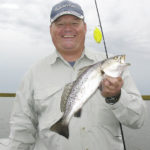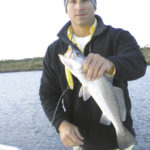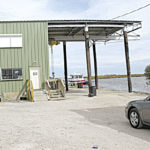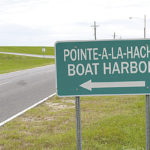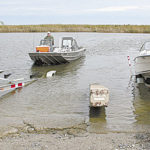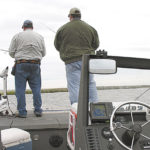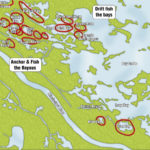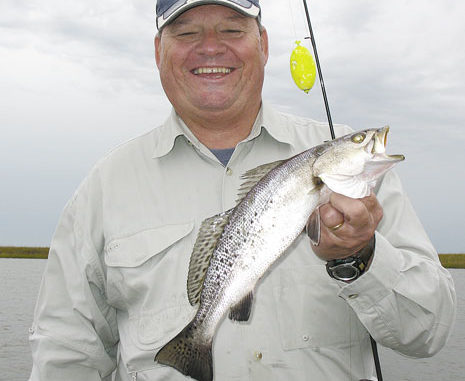
Don’t hesitate this month. Point the bow of your boat directly toward this perennial winter hotspot.
I met Brian McAdam for the first time in the dark hours of a cold morning on Paris Road in Chalmette. We agreed to meet there so I could hop in his truck and make a fishing trip with him and one of his long-time fishing buddies, Wayne Lobell. McAdam said I would easily recognize his truck — it’d be the one pulling a 22-foot Hanko.
When he arrived pulling the big rig, we exchanged greetings, and I tossed my gear aboard. We settled into the heated truck for the haul down to Pointe a la Hache.
McAdam has spent a lot of time plying those waters, and the last months of the year are among his favorites.
“I make the drive from my house in River Ridge to Pointe a la Hache because it holds one great attraction: fast limits of speckled trout, close to the dock,” he said. “And you don’t have as many boats out there vying for spots as you have at more-popular destinations.”
There’s a reason why: Pointe a la Hache is a pretty long haul, depending, of course, on where you live. For McAdam, it’s more than 70 miles one way, and almost 50 miles of it winds along the east side of the river on the narrow, two-lane, shoulder-less Highway 39. But it is good road, and it’s scenic. And the last 10-15 miles or so are so rural you could even describe them as desolate.
Beshel’s Marina is about a mile past the cut-off to the Pointe a la Hache ferry. The only sign you’ll see for the marina is relatively small and green, and easily missed on a dark morning. Look for it just before a tall, faded Chevron sign. Go over the levee, and then to the left to Beshel’s Marina (504-333-4469).
The marina was buried under 20 feet of water and pretty much destroyed by Katrina, but the Beshels did a good job of putting it all back together. The store is open, and the marina now has live bait year round. The hoist is still out of service, but a double backdown is available, and the launch fee is $10.
I was shocked by the line of vehicles waiting to launch. We arrived early — well before daybreak — and on a Monday morning. At least 20 vehicles were in line ahead of us.
“Word is out,” McAdam said. “When the trout show up, in close, the word spreads fast. Sometimes this line is to the levee and even past it. The thing about launching here is you have such a short boat ride to the prime fishing spots. It’s a longer drive by car, but a shorter ride by boat. You could launch in Delacroix — shorter by car, but a much longer boat ride. Or you could launch on the west side and hop across the river.”
Thirty minutes later, daylight broke, and we were making our way down the Back Levee Canal toward our fishing destination.
“It’s chilly,” McAdam said, “but still not cold enough to drive the fish deep. Our plan is to drift and fish the bays today, so snap on a cork.”
Within mere minutes from the dock, we were in some prime fishing areas — First Bay, Second Bay and Third Bay.
“The first thing I do is look for birds and slicks,” McAdam said. “If the birds are diving over bait, I’ll approach ahead of them so I can drift toward the action. Double beetles or Cocahoes under a cork are the ticket under the birds.
“If I don’t see birds, I’ll look for slicks and fish upcurrent from them. You should always look for signs of bait activity in the water also. If nothing grabs your attention, then see which way the wind and tide are moving, and position your boat so you can drift with the tide. Cast on both sides, trying both under a cork and tight-lining until you bump into some action.
“Once you get on a couple good hits, stick your power-pole or Cajun anchor over, and try to stay with the bite awhile. Right now, the fish tend to be scattered, and you might not catch a bunch in one spot. But you do come across schools where you could load up in one spot.”
We made a drift in Third Bay, and picked up a few trout. We then motored back to our starting point, and drifted the same area again. McAdam tossed a glow/chartreuse Cocahoe, and Lobell was casting an electric chicken. I had on tandem beetles, and we all put fish in the box, but the double rig was attracting a bit more attention than the singles. The action wasn’t as fast as we’d hoped, so I blamed it on Lobell.
“That ugly bait is scaring all the fish away,” I told him.
“I caught my limit using this color last week,” he replied.
“Well you must have caught all the stupid fish last week because the intelligent ones won’t bite that thing.”
We moved to Second Bay, picked up a few more trout and then to Wreck Bay, where we got on a pretty good bite under some birds.
“There are so many places down here that hold fish, and good fish,” McAdam said. “Wreck Bay is good, Little Crevasse has been hot, Bakers Bay is holding reds, and Grand Point Bay has been pretty productive. Those are all moderate-weather spots to drift and cast. You don’t usually catch the huge sizes right now that you see farther outside in the spring and summer, but I do find the fish to generally be larger in Pointe a la Hache than the Delacroix and Hopedale areas.
“Once it gets cold, the fish will move into the deeper bayous and canals, and Pointe a la Hache has plenty of those. The pass between Second and Third Bay is a perennial favorite, as is the mouth of Thorn Tree and the mouth of Big Four. Bayou Dominique.
“Bayou Boue and Francis Martin Bayou are other cold-weather favorites in the area. I like to anchor by a deep hole and cast upcurrent toward shallower water, letting my bait dribble down the ledge as I slowly bring it back toward me. The fish tend to hang along the ledges, and they’ll hit your bait as it falls down the drop-off.
“Usually we catch some reds in the mix along with the trout, but if I want to especially target redfish, I fish Bakers Bay. I like to work spinnerbaits and gold spoons as I troll along the shoreline, or you can anchor near points with some good current and fish dead shrimp under a cork. Reds will eat that up. The northwest corner of Bakers is generally pretty grassy this time of year, so working baits along the edges of the grass can be productive as well.”
Capt. Kerry Audibert (504-259-5304) grew up fishing Pointe a la Hache, and still makes his way over there by boat on a regular basis.
“Two things draw me toward Pointe a la Hache this time of year,” he said. “The size of the fish, and the abundance of bait in the water.”
Audibert agrees with McAdam — the fish are generally bigger in Pointe a la Hache, especially right now. And there is just more bait down there because of its proximity to the river.
“River shad, shrimp, pogies, storm minnows, mullet — there’s a lot more bait in the water to attract the fish and the birds,” he said. “And the fish showed up early this year. We’ve been nailing some pretty good fish inside for a couple months already.”
But Audibert says it can all change quickly, so you need to get in on the action this month before the corps cranks open the Diversion.
“Usually they open up the diversion sometime in January once the river rises, and that will flood Pointe a la Hache with river water, and that will push the trout out,” he said. “Even a hard northwest wind will push the good water out and bring in the muddy river water. But once we get an easterly or northeast wind, the good water will come right back in, and the fishing will resume where it left off. Apart from that, Pointe a la Hache will stay clean and hold good fish all winter.”
Audibert likes to fish the same bays and bayous that McAdam mentioned, all the ones that make Pointe a la Hache such an attractive angling destination. But he also likes to venture southeast toward John Bayou and Bayou Fusich, especially in colder weather.
“When it gets windy and cold and most anglers think you can’t catch fish, that’s the time to head to John Bayou, Bayou Fusich, and all the dead-ends off of Cox Bay,” he said.
Audibert says the turns in the bayous are normally deeper and are good places to look for reds and specks to stack up in colder weather, especially if you find a turn where a drain intersects the main bayou.
“The dead-ends have a lot of oak trees that hold reds, and any drains from the marsh and intersections will usually hold specks and reds,” he said. “The water stays pretty clear in there. It averages 6-8 feet deep, and it’s only about a 30-minute run from Beshel’s.
“As the shrimp disappear, the trout will switch to a finfish diet, so plastic Cocahoes and curl-tail baits fished slow off the bottom in the early hours will pay off. After the sun warms things up, the fish will move to nearby shallow flats and reefs, and topwater baits such as the MirrOlure She Dog, and shallow swimming hard baits like the Catch 5, Catch 2000 and MirrOdine will attract some good hits. Look for signs of mullet in the water, and toss those hard baits and topwaters.”
Once we reach the dead of winter, Audibert says the fish will congregate in the deeper bayous with a shell bottom, which tends to hold on to the heat a bit longer.
“Soft plastics, such as the Deadly Dudley Terror Tails and Hybrid Flurrys, on a ¼-ounce jig head, fished slow off the bottom, using braided line and a sensitive rod, will be the best bet,” he said. “The bite can be so slight, it’s almost imperceptible, so the braided line and sensitive rod will help you feel the bite.
“One other thing: There’s no need to get on the water at the crack of dawn in the winter. Sometimes I don’t even leave my dock until 10 a.m. Everything flip-flops in the winter. In the summer, the heat is your enemy. You want to get an early start before the heat shuts down the bite.
“But in the winter, the heat is your friend. You want to wait a little while and give the sun a chance to warm things up, and then the fish will be ready to come out to play.”
Capt. Kerry Audibert can be reached at (504) 259-5304.
